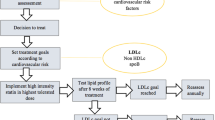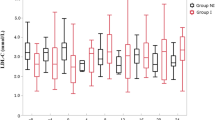Abstract
The effect of lipid-modulating treatments on modification of high density lipoprotein (HDL) subfractions remains unknown. In this study, mixed dyslipidemia patients (n = 100) inadequately controlled with a standard statin dose were randomized to switch to 40 mg of rosuvastatin or add-on extended release nicotinic acid/laropiprant (ER-NA/LRPT) or add-on fenofibrate. The cholesterol concentrations of HDL (HDL-C) subfractions and HDL-associated lipoprotein-associated phospholipase A2 (HDL-Lp-PLA2) activity were assessed at baseline and 3 months later. We observed that large HDL-C increased by 50 and 6 % in the add-on-ER-NA/LRPT and rosuvastatin groups, respectively, while it decreased by 20 % in the add-on-fenofibrate group (p < 0.01 vs baseline for all groups and p < 0.01 for all comparisons among groups). On the other hand, small HDL-C decreased by 17 % in the add-on-ER-NA/LRPT group (p < 0.01 vs baseline), while it increased by 25 % in the add-on-fenofibrate group (p < 0.01 vs baseline) without any change in the rosuvastatin group (p < 0.01 for all comparisons among groups). HDL-Lp-PLA2 activity increased by 55, 33 and 18 % in add-on-ER-NA/LRPT, add-on-fenofibrate and rosuvastatin groups, respectively (p < 0.01 for all comparisons vs baseline and for all comparisons among groups). In conclusion, add-on-ER-NA/LRPT was associated with an increase in large HDL-C and a decrease in small HDL-C, while opposite effects were noticed in the add-on-fenofibrate group. Add-on-ER-NA/LRPT was associated with the most pronounced increase in HDL-Lp-PLA2 activity.

Similar content being viewed by others
Abbreviations
- ANCOVA:
-
Analysis of covariance
- CETP:
-
Cholesterol ester transfer protein
- CVD:
-
Cardiovascular disease
- ER-NA/LRPT:
-
Extended release nicotinic acid/laropiprant
- HDL-C:
-
High density lipoprotein cholesterol
- HDL-Lp-PLA2 :
-
HDL-associated lipoprotein-associated phospholipase A2
- HL:
-
Hepatic lipase
- LDL-C:
-
Low density lipoprotein cholesterol
- NCEP-ATP:
-
National Cholesterol Education Program Adult Treatment Panel
- NMR:
-
Nuclear magnetic resonance
- PAF:
-
Platelet activating factor
- PROBE study:
-
Prospective, randomized, open-label, blinded end point study
- SD:
-
Standard deviation
- SPSS:
-
Statistical Package for the Social Sciences
- TAG:
-
Triacylglycerol(s)
- VAP:
-
Vertical auto profile
References
Link JJ, Rohatgi A, de Lemos JA (2007) HDL cholesterol: physiology, pathophysiology, and management. Curr Probl Cardiol 32:268–314
Asztalos BF, Cupples LA, Demissie S, Horvath KV, Cox CE, Batista MC, Schaefer EJ (2004) High-density lipoprotein subpopulation profile and coronary heart disease prevalence in male participants of the Framingham Offspring Study. Arterioscler Thromb Vasc Biol 24:2181–2187
Guha M, Gao X, Jayaraman S, Gursky O (2008) Correlation of structural stability with functional remodeling of high-density lipoproteins: the importance of being disordered. Biochemistry 47:11393–11397
Kontush A, Chapman MJ (2006) Antiatherogenic small, dense HDL–guardian angel of the arterial wall? Nat Clin Pract Cardiovasc Med 3:144–153
Rallidis LS, Tellis CC, Lekakis J, Rizos I, Varounis C, Charalampopoulos A, Zolindaki M, Dagres N, Anastasiou-Nana M, Tselepis AD (2012) Lipoprotein-associated phospholipase a(2) bound on high-density lipoprotein is associated with lower risk for cardiac death in stable coronary artery disease patients: a 3-year follow-up. J Am Coll Cardiol 60:2053–2060
Durrington P (2003) Dyslipidaemia. Lancet 362:717–731
Liberopoulos E, Vlasserou F, Mitrogianni Z, Papageorgantas I, Elisaf M (2012) Prevalence and risk distribution of residual dyslipidemia in statin-treated patients in Greece. Angiology 63:184–193
Kei A, Liberopoulos EN, Mikhailidis DP, Elisaf M (2013) Comparison of switch to the highest dose of rosuvastatin vs. add-on nicotinic acid vs. add-on fenofibrate for mixed dyslipidaemia. Int J Clin Pract 67:412–419
Kei A, Liberopoulos E, Tellis K, Rizzo M, Elisaf M, Tselepis A. Effect of hypolipidemic treatment on emerging risk factors in mixed dyslipidaemia: a randomized pilot trial. Eur J Clin Invest 2013
Third Report of the National Cholesterol Education Program (NCEP) (2002) Expert panel on detection, evaluation, and treatment of high blood cholesterol in adults (Adult Treatment Panel III) final report. Circulation 106:3143–3421
Kostapanos MS, Milionis HJ, Filippatos TD, Christogiannis LG, Bairaktari ET, Tselepis AD, Elisaf MS (2009) Dose-dependent effect of rosuvastatin treatment on HDL-subfraction phenotype in patients with primary hyperlipidemia. J Cardiovasc Pharmacol Ther 14:5–13
Kakafika AI, Xenofontos S, Tsimihodimos V, Tambaki AP, Lourida ES, Kalaitzidis R, Cariolou MA, Elisaf M, Tselepis AD (2003) The PON1 M55L gene polymorphism is associated with reduced HDL-associated PAF-AH activity. J Lipid Res 44:1919–1926
Airan-Javia SL, Wolf RL, Wolfe ML, Tadesse M, Mohler E, Reilly MP (2009) Atheroprotective lipoprotein effects of a niacin-simvastatin combination compared to low- and high-dose simvastatin monotherapy. Am Heart J 157:687.e1–8
Morgan JM, Capuzzi DM, Baksh RI, Intenzo C, Carey CM, Reese D, Walker K (2003) Effects of extended-release niacin on lipoprotein subclass distribution. Am J Cardiol 91:1432–1436
Ikewaki K, Tohyama J, Nakata Y, Wakikawa T, Kido T, Mochizuki S (2004) Fenofibrate effectively reduces remnants, and small dense LDL, and increases HDL particle number in hypertriglyceridemic men—a nuclear magnetic resonance study. J Atheroscler Thromb 11:278–285
Ballantyne C, Gleim G, Liu N et al (2012) Effects of coadministered extended-release niacin/laropiprant and simvastatin on lipoprotein subclasses in patients with dyslipidemia. J Clin Lipidol 6:235–243
Tribble DL, Farnier M, Macdonell G, Perevozskaya I, Davies MJ, Gumbiner B, Musliner TA (2008) Effects of fenofibrate and ezetimibe, both as monotherapy and in coadministration, on cholesterol mass within lipoprotein subfractions and low-density lipoprotein peak particle size in patients with mixed hyperlipidemia. Metabolism 57:796–801
Miyazaki T, Shimada K, Miyauchi K, Kume A, Tanimoto K, Kiyanagi T, Sumiyoshi K, Hiki M, Mokuno H, Okazaki S, Sato H, Kurata T, Daida H (2010) Effects of fenofibrate on lipid profiles, cholesterol ester transfer activity, and in-stent intimal hyperplasia in patients after elective coronary stenting. Lipids Health Dis 9:122
Agouridis AP, Kostapanos MS, Tsimihodimos V, Kostara C, Mikhailidis DP, Bairaktari ET, Tselepis AD, Elisaf MS (2012) Effect of rosuvastatin monotherapy or in combination with fenofibrate or omega-3 fatty acids on lipoprotein subfraction profile in patients with mixed dyslipidaemia and metabolic syndrome. Int J Clin Pract 66:843–853
Barter PJ, Brewer HB Jr, Chapman MJ, Hennekens CH, Rader DJ, Tall AR (2003) Cholesteryl ester transfer protein: a novel target for raising HDL and inhibiting atherosclerosis. Arterioscler Thromb Vasc Biol 23:160–167
van der Hoorn JW, de Haan W, Berbee JF, Havekes LM, Jukema JW, Rensen PC, Princen HM (2008) Niacin increases HDL by reducing hepatic expression and plasma levels of cholesteryl ester transfer protein in APOE*3Leiden.CETP mice. Arterioscler Thromb Vasc Biol 28:2016–2022
Rye KA, Clay MA, Barter PJ (1999) Remodelling of high density lipoproteins by plasma factors. Atherosclerosis 145:227–238
Sasaki J, Yamamoto K, Ageta M (2002) Effects of fenofibrate on high-density lipoprotein particle size in patients with hyperlipidemia: a randomized, double-blind, placebo-controlled, multicenter, crossover study. Clin Ther 24:1614–1626
Lee MH, Hammad SM, Semler AJ, Luttrell LM, Lopes-Virella MF, Klein RL (2010) HDL3, but not HDL2, stimulates plasminogen activator inhibitor-1 release from adipocytes: the role of sphingosine-1-phosphate. J Lipid Res 51:2619–2628
Gao X, Yuan S, Jayaraman S, Gursky O (2009) Differential stability of high-density lipoprotein subclasses: effects of particle size and protein composition. J Mol Biol 387:628–638
Lund-Katz S, Phillips MC (2010) High density lipoprotein structure-function and role in reverse cholesterol transport. Subcell Biochem 51:183–227
Salonen JT, Salonen R, Seppanen K, Rauramaa R, Tuomilehto J (1991) HDL, HDL2, and HDL3 subfractions, and the risk of acute myocardial infarction. A prospective population study in eastern Finnish men. Circulation 84:129–139
Lagos KG, Filippatos TD, Tsimihodimos V, Gazi IF, Rizos C, Tselepis AD, Mikhailidis DP, Elisaf MS (2009) Alterations in the high density lipoprotein phenotype and HDL-associated enzymes in subjects with metabolic syndrome. Lipids 44:9–16
Yancey PG, Bortnick AE, Kellner-Weibel G, de la Llera-Moya M, Phillips MC, Rothblat GH (2003) Importance of different pathways of cellular cholesterol efflux. Arterioscler Thromb Vasc Biol 23:712–719
Bergmeier C, Siekmeier R, Gross W (2004) Distribution spectrum of paraoxonase activity in HDL fractions. Clin Chem 50:2309–2315
Zheng C, Aikawa M (2012) High-density lipoproteins: from function to therapy. J Am Coll Cardiol 60:2380–2383
Florentin M, Liberopoulos EN, Wierzbicki AS, Mikhailidis DP (2008) Multiple actions of high-density lipoprotein. Curr Opin Cardiol 23:370–378
Boden WE, Probstfield JL, Anderson T, Chaitman BR, Desvignes-Nickens P, Koprowicz K, McBride R, Teo K, Weintraub W (2011) Niacin in patients with low HDL cholesterol levels receiving intensive statin therapy. N Engl J Med 365:2255–2267
Merck 2013 announces HPS2-THRIVE study of TREDAPTIVE™ (Extended-Release Niacin/Laropiprant) did not achieve primary endpoint. Available at: http://www.mercknewsroom.com/press-release/prescription-medicine-news/merck-announces-hps2-thrive-study-tredaptive-extended-relea. Last assessed 30 July 2013
Merck 2013 provides update on next steps for TREDAPTIVE™ (extended-release niacin/laropiprant) Available at: http://www.mercknewsroom.com/press-release/research-and-development-news/merck-provides-update-next-steps-tredaptive-extended-rel. Last assessed 30 July 2013
Ginsberg HN, Elam MB, Lovato LC, Crouse JR 3rd, Leiter LA, Linz P, Friedewald WT, Buse JB, Gerstein HC, Probstfield J, Grimm RH, Ismail-Beigi F, Bigger JT, Goff DC Jr, Cushman WC, Simons-Morton DG, Byington RP (2010) Effects of combination lipid therapy in type 2 diabetes mellitus. N Engl J Med 362:1563–1574
Tsimihodimos V, Kakafika A, Tambaki AP, Bairaktari E, Chapman MJ, Elisaf M, Tselepis AD (2003) Fenofibrate induces HDL-associated PAF-AH but attenuates enzyme activity associated with apoB-containing lipoproteins. J Lipid Res 44:927–934
Tellis CC, Tselepis AD (2009) The role of lipoprotein-associated phospholipase A2 in atherosclerosis may depend on its lipoprotein carrier in plasma. Biochim Biophys Acta 1791:327–338
Acknowledgments
The authors would like to thank the Atherothrombosis Research Centre of the University of Ioannina for providing access to the laboratory equipment and facilities.
Conflict of interest
Some of the authors have given talks, attended conferences and participated in trials and advisory boards sponsored by various pharmaceutical companies, including Astra-Zeneca, Abbott and Merck Sharpe and Dohme (MSD). There are no other conflicts of interest to be declared.
Author information
Authors and Affiliations
Corresponding author
About this article
Cite this article
Kei, A., Liberopoulos, E., Tellis, C. et al. Lipid-Modulating Treatments for Mixed Dyslipidemia Increase HDL-Associated Phospholipase A2 Activity with Differential Effects on HDL Subfractions. Lipids 48, 957–965 (2013). https://doi.org/10.1007/s11745-013-3826-y
Received:
Accepted:
Published:
Issue Date:
DOI: https://doi.org/10.1007/s11745-013-3826-y




